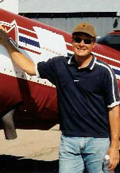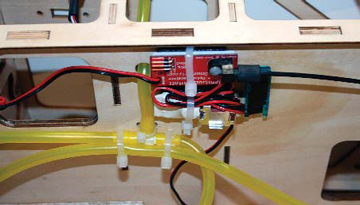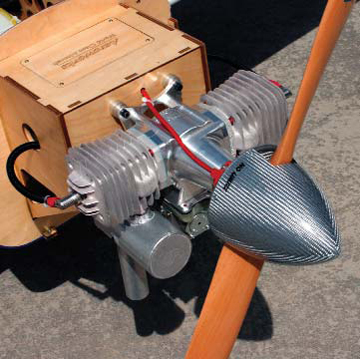 |
Scott Stoops is a commercial pilot for United Airlines who flies a full-scale Sukhoi 26MX in IAC competition for fun on his days off. The second edition of his book, The Pilots Guide to Mastering Radio Controlled Flight, is available at www.rcpilotguide.com. We are very pleased to offer Scotts insights to our readers. the editors |
One of the more unique things about aviation and aircraft is that both are wildly unforgiving of mistakes and inattention. This applies to full-scale as well as the model aviation we practice here. For instance, if you forget to fuel your car, you pull over to the side of the road very little threat. In an airplane, however, the engine quits and you hope to find a safe place to land within gliding distance which is a very high threat. For most of us, the rewards justify the risks which were actively prepared to manage. It is important to acknowledge that we can absolutely modify and manage the risks, which is what this article is about managing the risks of operating model airplane engines. This article has become very personal for me, as several of my friends have had severe injuries operating gasoline and glow engines in the last few years.
|
Use a high quality leather glove whenever you are hand flipping a gas engine to protect your hand from the sharp prop blades. |
GENERAL ENGINE SAFETY
Several years ago, I wrote an article on propeller safety as it relates primarily to electric aircraft. (find.flyrc.com/061121) One of the main points of that article was the idea that you should remain clear of the propeller arc at all times. If youre setting up a new motor or engine, ensure that either the prop is removed or that there is no power source to the ignition or speed control. Assume that the propeller could turn at any point. This is particularly important when showing your model to children as I can guarantee their first thought and action will be to turn the prop. Under the right circumstances, that could be deadly. This also applies to reaching through a stopped prop arc to attach or unplug a battery, secure a hatch, or reaching to adjust the needles. Keep your hands and body out of the prop arc!
GAS ENGINE STARTING
There are several important aspects to safely starting a gas engine including engine setup and switching, starting accessories, aircraft securing and flipping techniques. Ill cover each in sequence.
ENGINE SETUP
You have several different options with regard to setting up your gas engines throttle, ignition and choke. Do you need a choke servo? What about an ignition cutoff? Is an external switch enough? My preferred setup consists of a manual choke that I actuate from underneath the cowl as well as an optical ignition cutoff that is switched from my radio. I prefer this because it allows me to electronically switch the ignition on and off through the radio giving me positive control right at my fingertips. If the throttle servo fails, I can still shut the engine off remotely. The second best option, in my mind, is to use a separate choke servo and a switch for the ignition on the side of the model. That also allows me to shut the engine ignition off by actuating the choke remotely should the throttle servo fail. A third acceptable option is to use an integrated ignition battery eliminator and switching unit. The unit draws power from the main flight battery to power the ignition and plugs into the receiver as a radio operated switch to turn the ignition on and off. The main concern that I have with a simple setup is that the throttle servo can fail. Ive had several do so. It is the most at risk servo on the airplane being directly connected to the vibrating engine through a pushrod and generally mounted close to the engine. If that fails, you lose control of the engine. On the ground, the engine will likely stop responding, but may go to one extreme or the other. In flight it may do the same. Id prefer to be able to kill the engine rather than waiting for it to run out of fuel while in flight, or until it crashes.
 STARTING ACCESSORIES
STARTING ACCESSORIES
For most gas engines, the typical glow engine starter is simply too small. This forces you to use your hands to turn the propeller. In a perfect world, youll use a chicken stick to flip the prop, but I find that many engines have too high a compression to use a hand held chicken stick.
The Smart-Fly Optical Ignition Cutoff is a lightweight electronic ignition switch that lets you kill the engine at will, providing a nice backup in case of throttle servo failure.
In those cases, I recommend using a large thick glove to help protect your hand. Welders gloves work great as the prop may break your hand if it starts unexpectedly, but the thick leather glove will prevent it from taking the fingers clean off. After seeing friends with fingers sewn back on, that visual will remain with me forever. These engines may seem like toys, but they can injure and even kill so please take this seriously.
| Straddling a model with the stabilizer against the calves is a timetested technique for restraining a model during runup. |
SECURING YOUR AIRCRAFT
There are a lot of techniques to secure your aircraft out there and some work better than others. My personal favorite is to have a fellow pilot stand over the tail with the leading edge of the stabs against his calves. A variation of this is two friends, one standing in front of each wing with the wings leading edge secure against their legs. In both cases, the model is actively held secure during the starting sequence. The aircraft moving forward when it starts unexpectedly is our biggest threat during the start. You can also use ground based restraints that incorporate arms in front of the stabs to secure the model. They generally work fine, but as with anything mechanical they can fail. If your plane starts at a high throttle and the restraint is staked into soft ground, it can easily come loose and release the plane. One method that is my least favorite is to tie the model off with a cord or strap to an unmovable object such as a bench or a tree. While this can work, you must be diligent about ensuring the cord or strap is taught between each flip of the prop. I am aware of a couple starting accidents where the aircraft was slowly pushed back during repeated starting attempts causing a slack to form in the strap. When the model started, it jumped forward into the pilot and caused significant injury. Regardless of the technique you use, I do recommend flying with others if at all possible. In the event you are injured, it might be nearly impossible to drive yourself to the emergency room. By using thebuddy system, youre ensured that you not only have a pilot to help you start the aircraft, but also to back you up on following these safety rules.
 FLIPPING TECHNIQUES
FLIPPING TECHNIQUES
When I first learned to prop a fullscale airplane, the two most important items were ensuring the aircraft was secure and ensuring that my propping motion kept me clear of the arc with my body weight falling away from the prop. Of course you also need to secure any loose clothing or jewelry that can become tangled in a turning prop. Since most of us dont wear jewelry to the flying field, the real threat there is a radio strap. Tuck it in your shirt or jacket, or simply remove it. I usually start the engine with the radio in my left hand and my thumb on the throttle.
I prefer to mount the propeller on my gas engines so that it is at about a 45-degree angle as shown when up against compression. This lets me pull it through briskly with my right hand and still clear the prop arc as quickly as possible.
Back to the original discussion; give the model a good tug between each prop attempt. Ensure that it is fully seated in its restraint and secure. Should it move forward it may jump into your hand or body. I prefer to mount my propellers with one blade at the 1-2 oclock position when it reaches the top of the compression stroke. This allows me to prop the engine through the compression stroke at the top of the prop arc with my hand rapidly clearing the arc in the engine turning direction. This also allows me to start my engines from a slightly bent or crouched position while mostly standing instead of being on one knee. From a knee, it will take me quite a bit longer to stand to retreat should the airplane break free from its restraint.
CONCLUSION
As in all things, there really is no absolute safety. One item that can dramatically improve the odds that youll operate safely is your personal attitude towards safety. Whether you decide to incorporate these ideas and other safe practices into your daily operation is entirely up to you. In fact, in many ways the safety of your fellow pilots at the flying field is also up to you, and your safety is up to them. Until next time, remember that learning is fun, and fun is what this great hobby is all about.
 Fly RC Magazine WE LIVE RC
Fly RC Magazine WE LIVE RC
